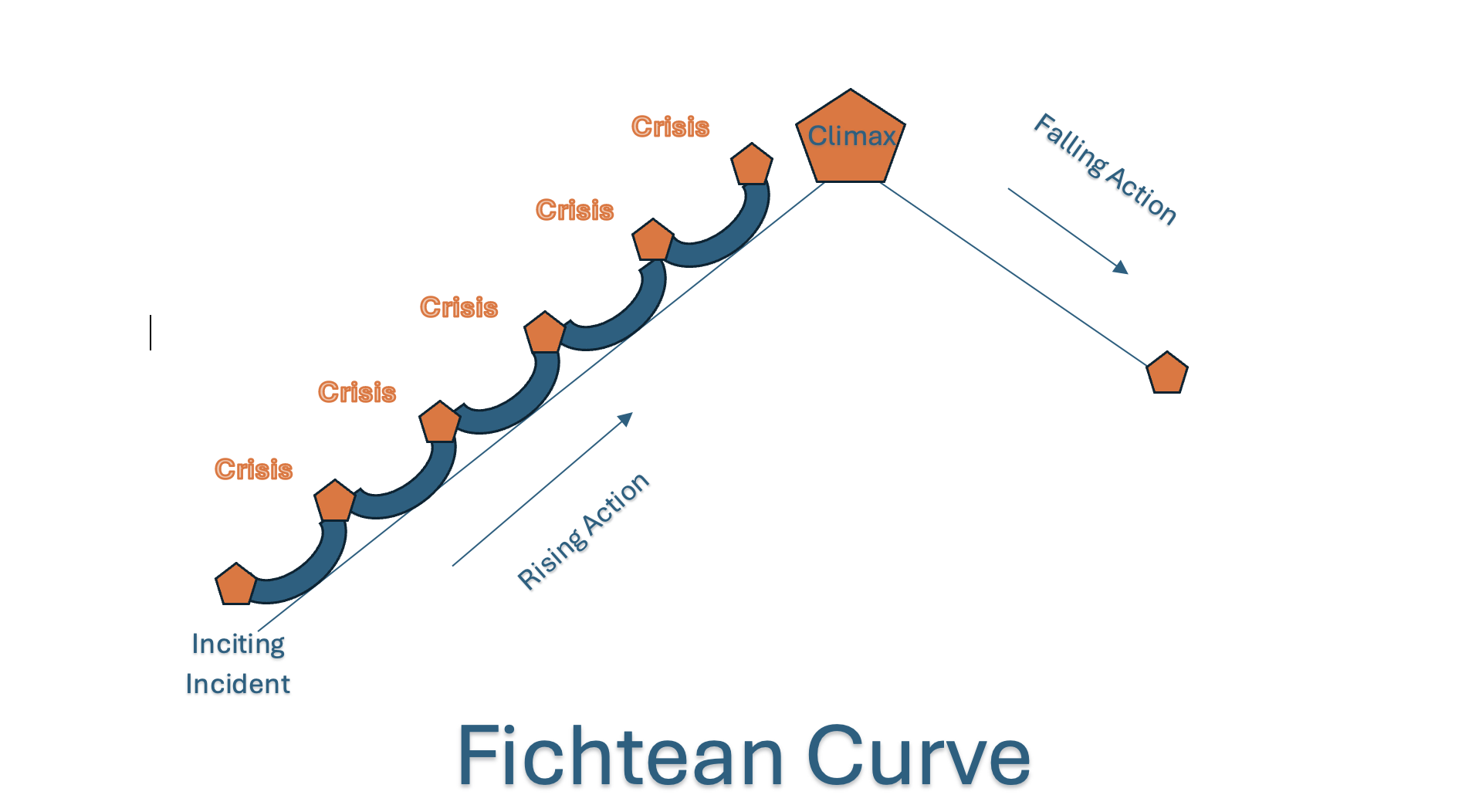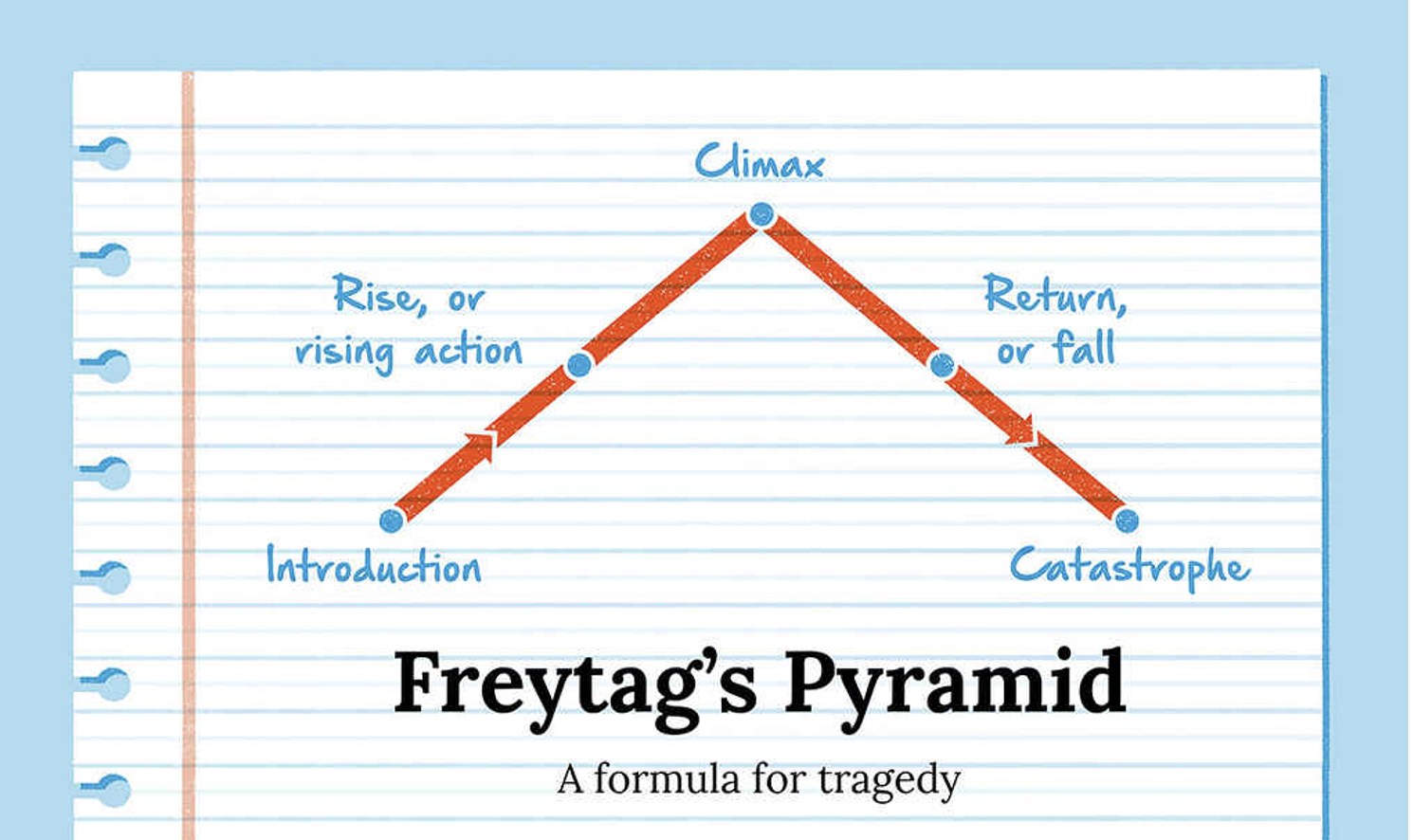Story Structure Series: The Hero’s Journey
Pauline J. Grabia participates in the Amazon Services LLC Associates Program, an affiliate advertising program, and earns from qualifying purchases from links in this post.
Please subscribe to my email newsletter for updates on my website and blog, and exclusive access to exclusive material in the Subscriber Content page of this website (see menu bar above). New content will be added regularly. You can sign up in the form found in the footer of this page. Thank you!
Introduction:
During this series on story structure and the different types of story structures used in writing, we’ve explored how story structure is an essential part of any story. It’s the framework or skeleton for everything else creating a story. We’ve looked at Freytag’s Pyramid and the Fichtean Curve. Today, we will explore a story structure called The Hero’s Journey. This structure has inspired stories from the myths of ancient civilizations to the screenplays for modern TV and film to favorite adventure novels. The Hero’s Journey is also known as the Monomyth, and it gained popularity in Joseph Campbell’s mythology book, The Hero with a Thousand Faces. In Campbell’s book, there are a total of seventeen steps or parts that make up the Monomyth. We will explore an adaptation of this, which involves 12 steps, a framework popularized by Christopher Vogler in The Writer’s Journey.
The Hero’s Journey or Monomyth goes beyond the constraints of genre or time periods. Its relevance to us today comes from its ability to deal with universal themes that resonate with people on an emotional level from every sphere. The plot is timeless and boiled down to three critical stages: the Departure, The Initiation, and The Return.
The Twelve Steps of the Hero’s Journey:
The first stage, or The Departure, involves the first four of the twelve steps.:
1. The Ordinary World: The storyteller starts by familiarizing the reader/watcher with the Hero’s known or “ordinary” world. This is where everything is situation-normal, and the world is established—the setting, characters, and theme are established, and the reader/viewer is given a reason to root for the Hero. The Hero (which can be any gender or genderless) is found lacking something or yearning for something they don’t have. They don’t yet have the motivation or ability to obtain what they lack.
· We will examine two movies, Rocky (1976) and Star Wars: A New Hope (1977), as classic examples for each step.
· In Rocky, Rocky Balboa is our hero, and his ordinary world is where he lives in the lousy part of Philadelphia as a mediocre boxer and loan collector who barely makes enough to survive.
· In Star Wars: A New Hope (SW), we have an archetypal hero in Luke Skywalker. A dreamer, he lives a mundane life with his aunt and uncle on the distant desert planet of Tatooine, craving adventure.
2. Call To Adventure: Usually starting around the 12% mark of the story, this step is also known as the Inciting Event or Inciting Incident. This is where something happens to tip the apple cart, disrupting the hero’s ordinary world and forcing them out of their comfort zone. They are confronted by a problem or conflict that they can’t ignore. This step must propel the plot forward; thus, it must be significant and exciting.
· In Rocky, this is when the heavyweight boxing champion Apollo Creed boosts interest in a big fight by offering a no-name loser—Rocky Balboa—the opportunity to fight for the championship.
· In SW, Luke accidentally activates a hidden message from Rebel leader Princess Leia that the droid R2D2 is supposed to deliver to Obi-Wan Kenobi.
3. The Refusal of the Call: This step begins around the 15% mark of the story. The Hero digs in their heels and refuses to be drawn into the adventure or conflict. It might be due to the conflict posing too significant a risk or danger for the Hero. Whatever the reason, it must be reasonable enough for the Hero to refuse the call to action, at least initially.
· In Rocky, Rocky Balboa declines the fight opportunity because he lacks a trainer and is out of condition for such a fight. He also doubts his ability to compete.
· In SW, Luke doesn’t want to get involved in the political cause of the Rebellion and rescue Leia. This doesn’t change until Luke suffers a personal loss at the hands of the Empire—the murder of his aunt and uncle and the destruction of his home.
4. Meeting The Mentor: In this fourth step, which begins around the 20% mark, the Hero has changed their mind and is willing to go on the adventure or face the conflict, but they are too inexperienced to succeed. They need someone to teach and guide them. Enter the Mentor figure, who acts as this source for training and equipping. The Mentor imbues the Hero with confidence and competency (both mental and physical), all done with a little tough love. The Mentor doesn’t have to be a person. It can be a source of information, like a map, guidebook, or talisman. The Mentor is essential for the Hero to prepare for their goal.
· In Rocky, the Mentor is former boxer Mickey Goldmill, who sees potential in Rocky and agrees to train him physically and mentally for the fight against Apollo Creed.
· In SW, the Mentor is the old man Luke knows as Ben, a Jedi Knight known as Obi-Wan Kenobi. Luke turns to him for support, having lost everyone else to the Empire.
The next stage of the story is known as The Initiation and includes the following four steps:
5. Crossing the First Threshold: This step begins around the 25% mark of the story, towards the end of the first act in other types of story structure. Here is the Point of No Return, where the Hero completely commits themselves to the adventure or conflict. They are committed and ready. By now, the central conflict should be apparent to the reader/viewer, as well as the central theme(s) and motifs. The dramatic turning point is conducted or orchestrated by the story’s antagonist, thus showing their power, which must be formidable. In many stories, this is where the Mentor is killed or destroyed, leaving the Hero alone again. The hero’s reaction to this loss, whatever it may be, should be consistent with the Hero’s character established to this point.
· In Rocky, Rocky’s point of no return occurs when he accepts the challenge of fighting with Apollo Creed on live television. It also happens when he approaches the love interest, Adrien, and asks her out on a date.
· In SW, this is when Luke, Obi-Wan, and the droids enter the dangerous Mos Eisley Spaceport, looking for a ride off Tatooine.
6. Tests, Allies, and Enemies: Occurring around the 30% mark, or the beginning of Act 2, the Hero faces new tests and challenges that involve the introduction of allies to the Hero’s cause, who help the Hero. The Hero needs help to reach their goal after the blow from the last step. At the same time, new enemies are introduced to the reader/viewer, who create new barriers for the Hero and their allies. The Hero may be confused and overwhelmed by the new rules and roles of this strange new world they find themselves in. The allies and the Hero may disagree on how to proceed, but their ultimate goal is the same. The reader/viewer should be presented with good reasons to cheer for the new allies.
· In Rocky, our Hero struggles to win Adrian over and keep his dubious relationship with her brother, Paulie.
· In SW, Luke and Obi-Wan hire Han Solo and Chewbacca to transport them off Tatooine in the Millennium Falcon. Luke's tests begin in earnest during this departure from the desert planet.
7. (Approaching) The Innermost Cave: This starts around the 40% mark and involves reflection on the challenges the Hero and their allies faced in the previous steps. The Innermost Cave is the most perilous place for the Hero in this Other Word. As each step takes place and each obstacle is faced, the stakes and tension must rise to a crescendo at the story's climax. The Hero and their allies might be beaten up and in disrepair, but they are still alive and committed to the cause. They continue to press forward toward their goal. Note that the Hero is approaching the Innermost Cave but hasn’t entered it yet.
· In Rocky, Rocky’s psyche is the Innermost cave—his fear of failure—which is revealed in his confrontation with Mickey.
· In SW, this occurs when the Millennium Falcon encounters trouble, is captured by the Death Star’s tractor beam, and is pulled aboard.
8. The Ordeal: Starting at the 50% mark, this is where the protagonist earns the title of hero. To this point, it is the most transformative event in the Hero’s story, where they hit rock bottom. With the help of allies, the Hero confronts their greatest fear and emerges from the experience transformed. This changes how the Hero encounters and meets every future event and obstacle. This is not the climax, but it is a profound event. The allies must be developed as multifaceted characters during this so the reader/viewer can cheer for them.
· In Rocky, the hero endures intense training and discipline until he hopes to succeed.
· In SW, Obi-Wan separates from Luke to disengage the tractor beam while Luke, Han, and Chewy come to the rescue of Princess Leia. Obi-Wan and Darth Vader encounter each other and fight a lightsabre duel during which Obi-Wan sacrifices his own life to give the others time and opportunity to escape.
9. Reward: Also known as “Seizing the Sword,” this occurs at 70%. Here, the end of the quest is within sight, and the hero sees the proverbial light at the end of the tunnel. The reward is what the hero and their allies have fought for. All that’s left to do is to seize it. The reward must be significant enough for the hero to face off against and conquer the antagonist at the story's climax. It must be clear to the reader/viewer what the reward is and its significance. This event is the end of Act Two.
· In Rocky, the reward is his restored confidence, self-esteem, and belief in himself. He now believes he can go the distance against Apollo Creed.
· In SW, Luke and his allies now possess Princess Leia and the Death Star plans. Although he mourns Obi-Wan, Luke envisions a path to victory ahead.
This final stage is known as The Return and includes steps 10 to 12:
10. The Road Back: At the 75% mark, the hero realizes that the light at the end of the tunnel isn’t as close as they thought. This being the beginning of Act 3, the hero tries to return to their ordinary world, but something still stands in their way. The conflict isn’t quite over. Having to deal with the consequences and aftermath of what the hero has already done, they are in the greatest danger they have ever been in and must face the antagonist in a face-to-face showdown to end the conflict. There is no other choice. Here, the central conflict must be re-established, and the consequences of failure must be made clear to the reader/viewer.
· In Rocky, the championship match between Rocky and Apollo Creed begins. They are evenly matched, and there is no indication of a clear victory. It could go either way.
· In SW, the Millennium Falcon is attacked, forcing Luke and his allies to go to the Rebel base to deliver the Death Star plans. Luke can’t go home yet. The Death Star still must be destroyed.
11. Resurrection: Beginning around the 88% mark, or the beginning of the climactic sequence, this is where the showdown occurs between the hero and the antagonist or villain. It is the highest point of conflict and tension in the story. Did the hero learn their lessons well enough to succeed and defeat their opponent? Usually, a miraculous and/or near-death victory occurs for the hero, after which they are entirely transformed or resurrected. It usually requires a big sacrifice on behalf of the hero to achieve this victory.
· In Rocky, both Apollo and Rocky endure severe beatings, yet Apollo does not defeat Rocky. Rocky survives 15 grueling rounds.
· In SW, Luke joins the Rebel fighters in their attack on the Death Star. Obi-Wan’s Force ghost reminds Luke to trust in the Force, which he does, allowing him to hit the target perfectly and destroy the Death Star. As a result, he becomes the hero of the mission and learns to wield the Force effectively against his enemies.
12. Return with the Elixir: This begins at the 95% mark and carries the reader/viewer to the end of the story. It is the resolution and conclusion. The hero returns to their ordinary world, the triumphant victor. They are transformed for the better and use their new knowledge, skills, and abilities to better their ordinary world. Here, the hero’s inner conflict is re-examined, showing how it has been resolved, resulting in their transformation and completing the character arc. If the story is the first in a series, this is where the hook for a subsequent story is provided for the reader/viewer.
· In Rocky, Rocky eventually loses the fight, but he’s gained something much more valuable—his self-confidence and Adrien’s love.
· In SW, Luke returns to the Rebel base triumphant, receiving medals and glory for his success. He feels confident about whatever challenges he may face in the future. Darth Vader survives the destruction of the Death Star, providing the viewer with a hook for the next story in the series.
Other Examples of the Hero’s Journey in Literature and Movies:
· The Martian (2015)—Movie
· The Lord of the Rings: The Fellowship of the Rings by J.R.R Tolkien
· The Hunger Games by Suzanne Collins
· Wild (2014)—Movie
· The Odyssey by Homer
· The Left Hand of Darkness by Ursula K. LeGuin
· The Lion, the Witch, and the Wardrobe by C.S. Lewis
· The Handmaid’s Tale by Margaret Atwood
· The Hero of the Crown by Robin McKinley
· The Lion King (1994)—Movie
· The Matrix (1999)—Movie
Coming next:
Most people are familiar with the three-act story structure, which we will examine in the next blog post. Most modern movies and plays follow this structure in one form or another. It is not quite as complicated as the Hero’s Journey and can be easily adapted to be used in almost any genre.
Thank you so much for reading this post and visiting my blog. Please sign up for my newsletter for a monthly update about the website and blog and exclusive access to the material on my Subscriber Content page at www.paulinejgrabia.com. I am honored that you have taken time out of your day to read what I have to offer, and I will endeavor to continue to post blogs that are worthy of your continued attention. May God bless you richly.
Pauline J. Grabia





In previous posts, we have explored various forms of story structure, including Freytag’s Pyramid, the Fichtean Curve, and the Hero’s Journey. Each of these is an effective story structure for a writer, depending on the narrative. The Three-Act Story Structure is one of the most used story frameworks in literature and film. This structure divides the story into three main sections or acts: Act 1, the Setup (or Beginning); Act 2, the Confrontation (or Middle); and Act 3, the Resolution (or Ending). This will not be a comprehensive exploration of the three-act structure, as there are other blogs listed at the end that do a much better job than I could of deeply examining the elements of this structure.